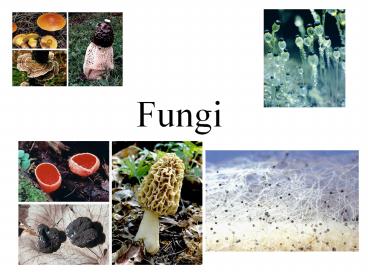Fungi - PowerPoint PPT Presentation
Title: Fungi
1
Fungi
2
- Multicellular except for yeast
- Cell walls made of chitin
- Mycelium body of the fungus
- Hyphae filaments that make up the mycelium
- Classified by method of sexual reproduction can
also reproduce asexually - -Myco or -mycete fungi
- Heterotrophic by absorption
- Decomposers - feeding on dead and decaying
organisms or parasitic living in or on another
organism, possibly causing disease - NO chlorophyll! NOT photosynthetic
3
(No Transcript)
4
- Kingdom Fungi
- Three phyla of fungi, based on method of sexual
reproduction - Zygomycota
- Basidiomycota
- Ascomycota
- Use the information in the following slides to
complete the table in your notes. - Note that some fungi are classified as
Deuteromycota or Fungi Imperfecti because the
method of sexual reproduction has not been
discovered. When it is, they will be placed in
the appropriate phylum.
Protist that gave rise to the fungi
5
- Zygomycota
- Fungi that reproduce with zygosporangia
structures resistant to freezing and drying,
allowing the organism to live through tough
times - Have no walls in their hyphae (multinucleate
cells) - Ex) Pilobus (top picture) can aim its sporangia
toward light where grass is likely to be growing,
then shoot spores to the grass. Important
because they depend on grazing animals, like
cows, to scatter the spores through feces. - Ex) Rhizopus stolonifer - black bread mold
(bottom picture) diagram p. 485
6
- Basidiomycota club fungi
- Fungi that reproduce with basidia (an external
club-like structure found under the cap of a
mushroom) that bear spores - Hyphae are divided by walls, but usually walls
are incomplete so cytoplasm can still move from
cell to cell important in eating - Ex) mushrooms, puffballs, rusts, smuts, shelf
fungi
Stinkhorn fungus
mushroom
Shelf fungus
7
Fairy ring results from the outward growth in
all directions of a basidiomycete (mushroom) the
structures visible above the ground are the
reproductive structures the body of the fungus
(mycelium) is in the ground
8
Examples of basidiomycetes Rusts, smuts, ergots
Fun Fungi Fact
Ergots can cause gangrene, nervous spasms,
burning sensations, hallucinations, temporary
insanity, and death when accidentally ingested
In 944 A.D. more than 40,000 people died in
France from ergot poisoning. It contains one of
the active ingredients found in LSD. Oddly
enough, it has been used for medicinal purposes
in treating high blood pressure and stopping
maternal bleeding following childbirth
Some of the witch hunts of 17th century America
have been attributed to ergot poisoning as it is
a common pest in rye.
9
- Ascomycota sac fungi
- Fungi that reproduce with internal sac-like
structures called asci that are full of spores - Hyphae are divided by walls, but usually walls
are incomplete so cytoplasm can still move from
cell to cell important in eating - Ex) cup fungi, yeast, morels, truffles
An edible morel
Truffle worth 600 a pound
10
Yeast budding (study guide question 8)
Budding asexual reproduction
Yeast are ascomycetes
11
Mold
Note the zone of inhibition around this
Penicillium
Penicillium - an ascomycete commonly called
mold that naturally produces an antibiotic
bacteria
12
What color are fungi NOT? What is missing in the
fungi that would make them that color? (Hint
look at the autotrophic, multicellular organism
with cellulose in its cell walls surrounding many
of these fungi)
Answer CHLOROPHYLL
HOW is that evidence that fungi are
heterotrophic? What is missing in the fungal
cells that are present in the other organisms
cells????
Answer No cholophyll means no chloroplasts. No
chloroplasts means no photosynthesis. No
photosynthesis means heterotroph.
13
Fungal Partnerships Symbiotic relationship one
in which two species live together in a close,
long-term association ex) mutualism both
benefit (mycorrhizae lichens) ex) parasitism
host organism is harmed, the parasite
benefits ex) commensalism one organism is
neither harmed nor benefits, the other benefits
14
Fungi are heterotrophic. Parasitic fungi
penetrate a living organism with specialized
hyphae to allow the fungus to absorb nutrients
from its host. Other fungi can prey on organisms
that wander into its path by trapping the prey
with specialized hyphae upon contact and then
penetrating the organism with a different type of
hyphae (nematode caught by fungus)
15
Lichen mutualistic relationship between a
photosynthetic organism and a fungus -
important pioneer species, especially in primary
succession
16
Effects of mycorrhizae(word parts fungus
root) on plant growth Myccorhizae mutualistic
relationship between a fungus and a plant root
- the plant supplies the fungus with
carbohydrates while the fungus absorbs phosphorus
and other minerals from the soil and passes them
to the plant, which would be unable to get these
minerals without mycorrhizae - fossilized
plants have mycorrhizae, showing that they
probably couldnt have moved on to land without
fungi!
Fun Fungus Fact Most mushrooms that grow at the
base of trees are actually the reproductive
structures of mycocorrhizae
Plant without Plant with
mycorrhizae mycorrhizae
17
Fungi and animals evolved from a common,
flagellated, protistan ancestor
- Animals probably evolved from aquatic flagellated
organisms too. - Molecular evidence from comparisons of several
proteins and ribosomal RNA indicates that fungi
are more closely related to animals than to
plants. - Remember the chitin!!!!
18
Important Fungal Traits Principal
decomposers Pioneer species Pollution indicators
(p. 492) Nitrogen fixers Symbionts Antibiotic
producers Also, flavor cheese, make bread rise,
used in beer brewing, wine making, as well as
providing a food source for many organisms
(mushrooms!)

